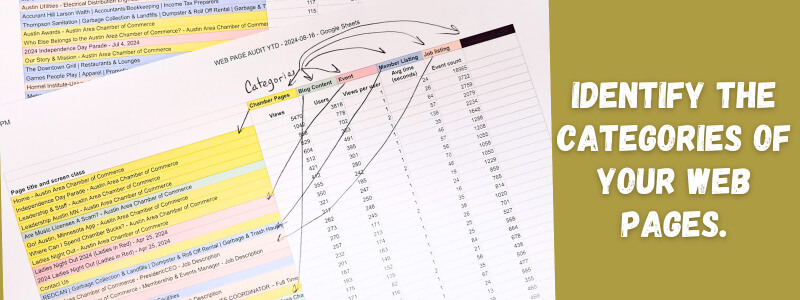The Website Audit: A Simple Method for Updating Your Website

Today, I’m pulling back the curtain on our latest project: a complete audit and refresh of the Chamber’s website. Why, you ask? Because even websites deserve a spa day now and then.
The Context: It's Been a While...
Like many websites, the Chamber's has been chugging around with nothing breaking, and so it has been easy to do the routine updates and add a blog now and again, but now with some major staff changes, it's a good time for us to really dig in and freshen our message and our photography, etc.
But where to begin? I like to start with data, aka "metrics." That's where the website audit comes in.
What Is a Website Audit?
A website audit is like giving your website a full-body check-up. It's about diving into every corner of your site to see what’s working great, what might need a little TLC, and where you can add some extra sparkle. Whether it’s freshening up content, tweaking the design, or making sure everything’s easy to find, the goal is to make your website the best it can be—so visitors get what they need, and your business gets what it needs from visitors. For purposes of our website audit, we used the "Site Content" report from Google Analytics under the "All Pages" section. This report provides detailed information on how individual pages on your website are performing, including metrics like pageviews, unique pageviews, average time on page, and bounce rate. For the Chamber's website, I pulled this report to rank pages year-to-date (YTD) and categorized them to help assess which pages are performing well, which might need improvements, and to assess our navigation levels.
Why Start with a Website Audit?
Let’s face it: our website is our digital front door, and like any good host, we want to make sure it’s not stuck in the ‘90s with dial-up speeds and a photo of staff members you fired ten years ago. The first step in our journey to a fresh, user-friendly site was to conduct a website audit using our trusty sidekick, Google Analytics. Think of it as giving the website a thorough check-up, but with fewer awkward conversations about flossing. Our goal (and yours should be too) is to have a website that’s easy to navigate and filled with relevant content. It helps your customers find what they need quickly and effortlessly, which means more happy customers and, ultimately, more business for you. And who doesn’t want that?
Step One: Analyzing the Data (a.k.a. Staring at Spreadsheets)
The first thing I did was dive into the treasure trove of data that is Google Analytics. I pulled the Site Content report that ranked our website’s pages by traffic count, bounce rate, and other nerdy metrics that made my Creative Writing degree weep just a little bit. Unless you love spreadsheets this might sound like a snooze fest, but stick with me.
Here’s the deal: this data gave us a bird’s-eye view of how visitors interact with our site. Which pages are they flocking to? Which ones are they fleeing from like they just saw a ghost? This kind of intel is golden because it tells us what’s working and what’s not.
Over the course of my marketing career, lo these many years, I have been asked to create web pages for the sake of having a web page that someone within an organization thought was important, but that no one outside of the building cared one iota about. During this audit, those pages might show low traffic and high bounce rates, meaning that the two people in North Korea who did visit those pages hated them. The metrics prove that these low-traffic pages don't merit surviving on their own - or that they require serious reworking - and they don't merit being represented in the navigation.
(Your new mantra: Keep the navigation clean, keep the navigation clean, keep the navigation clean.)
For example, if a page has a high bounce rate, it’s basically the website’s way of saying, “This page needs some love!” Maybe the content isn’t engaging, or the page takes too long to load. Or maybe it’s just not what visitors are looking for. Whatever the reason, we can use this information to make improvements.
Step Two: Categorizing the Pages (a.k.a. The Sorting Hat Has Nothing on Me)
Next, I channeled my inner librarian (minus the shushing) and categorized the pages into types: blog posts, member directory listings, Chamber information (like the riveting “About Us” page), event pages, job listings, and Business Spotlights. Why? Because not all pages are created equal. Some are like the MVPs of our site, while others are more like the benchwarmers. But even benchwarmers have potential, right?
By sorting the pages, I could see patterns emerge. Certain types of pages were consistently pulling in traffic (looking at you, Business Directory), while others were more hit or miss. This categorization helped us prioritize which pages to keep, tweak, or—cue dramatic music—cut.

Step Three: Planning the Refresh (a.k.a. Time for a Makeover)
With the data in hand and the pages sorted like a pro, it was time to roll up my sleeves and get to work. The big takeaway? Our website’s navigation needed a bit of an overhaul to make it easier for visitors to find what they’re looking for without the digital equivalent of getting lost in the woods.
Here’s a sneak peek at what’s coming: streamlined navigation with top-level headings like “Find a Business,” “Join the Chamber,” “Events & Programs,” “Live & Work in Austin,” and yes, an "About Us" section. We’re also freshening up the content and graphics to make sure everything looks sharp and polished—kind of like when you finally clean out your garage, and suddenly it’s a space you actually want to spend time in.
Like my coffee cup. Do you think I should clean it, or would it lose its "established taste profile?"

What This Means for You
So, why am I telling you all of this? Because whether you’re a Chamber member or just a fellow small business owner, the process we’re going through could be a game-changer for your website too. If you haven’t given your site a thorough check-up lately, now might be the perfect time.
Start by diving into your analytics (don’t worry, it’s not as scary as it sounds) and see what’s working and what’s not. Then, take a hard look at your content. Is it engaging? Is it relevant? Does it speak to your audience? And most importantly, is it leading them to take action—like clicking that magical “Buy Now” or "Contact Us" button?
Ready for the New and Improved Chamber Website?
We’re excited to unveil the new and improved Austin Area Chamber of Commerce website soon, and we’re confident that these changes will make it easier than ever for you to connect with the resources and opportunities you need to succeed.
In the meantime, if you’re feeling inspired to give your own website a little TLC, remember that a good place to start is with a solid audit. And hey, if you need a little help along the way, you know where to find us (hint: we’re the Chamber with the shiny new website).
Until next time, keep those pages loading fast and those customers clicking!
UPDATE: As of 10:03 AM, I have not yet cleaned my coffee cup.

Chaunce Stanton
Director of Marketing & Communications
Austin Area Chamber of Commerce
Other Marketing Posts
Facebook Reels vs. Video Posts: Which Should Your Business Use?
Facebook Reels vs. Video Posts: Which is better for your business? We analyzed real data from the Austin Area Chamber to compare reach, engagement, and audience growth. Discover key takeaways to boost your video strategy today!
Who Got It Right? Top 50 Facebook Pages in Austin, MN
Having a Facebook page isn’t enough to grow your business—engagement is key! Discover the Top 50 most-followed Facebook pages in Austin, MN, why audience growth matters, and how local businesses can boost visibility by working together.
Top Five Hair Salons in Austin, Minnesota
Discover the top 5 best salons in Austin, TX with excellent customer reviews and ratings. Explore professional beauty services from Austin Area Chamber of Commerce members and more. Find your next favorite salon today!
What Is Minnesota Nice? The Truth This TIme
Minnesota Nice isn’t all smiles and warm welcomes—it’s a complex mix of kindness, passive-aggression, and unspoken judgment. Dive into the real meaning behind this Midwestern trait and why it’s time to be a little more Nice Nice
Robots Love a Parade! AI and Fake Engagement in Social Media
Noticed old Facebook posts getting sudden engagement? AI bots might be behind it. Learn how fake engagement affects your social media and what it means for businesses.
YEAR 1: What We’ve Learned About Austin, Minnesota
Discover what we’ve learned about Austin, MN through one year on the Go! Austin Minnesota App! From the most-clicked buttons to favorite businesses and community trends, explore how residents and visitors use the App to connect, dine, and explore. Download now: bit.ly/go-austin-mn
Hacked & Locked Out: Facebook Business Page Nightmares
Experiencing a hack on your Facebook business page can be more than just a little annoying: it can cost you money, time, and brand reputation. Implement preventive measures to protect your business presence.
Let’s Build Some Brand Equity for Local Businesses
by Chaunce Stanton Director of Marketing & Communications Austin Area Chamber of Commerce Let’s Build Some Brand Equity for Local Businesses Let’s play a matching game! I say, The car in ‘Back to the Future.’ You say… Delorean, of course. Were there other cars in that movie? Of course, but the time-travelling Delorean probably comes…
From ‘On the Go’ to ‘On the Couch’—How Consumer Preferences Have Shifted in 20 Years
Consumer Preferences: From On the Go to On the Couch by Chaunce Stanton Director of Marketing & Communications Austin Area Chamber of Commerce How Consumer Preferences Have Shifted in 20 Years Over the past two decades, the landscape of brand loyalty has undergone a dramatic transformation, indicating major changes to consumer preferences-and it says a…
The Website Audit: A Simple Method for Updating Your Website
When it’s time to freshen your website, where should you begin? Use metrics to perform a website audit to help you assess content and navigation needs.











